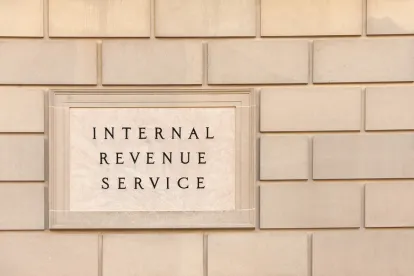The IRS issued Interim Guidance that likely will increase the expense and burden of filing research credit refund claims. Research credits in original returns are not affected by the Interim Guidance.
On January 3, 2022, the IRS issued Interim Guidance and Frequently Asked Questions setting forth the procedure IRS personnel must use to determine whether a research credit refund claim is legally sufficient. In a prior alert, we discussed Field Attorney Legal Advice 20214101F (October 15, 2021) in which the IRS Chief Counsel set forth his interpretation of the rules determining whether a research credit refund claim is legally sufficient. The Interim Guidance makes the Field Attorney Legal Advice operational. The bottom line is that filing a research credit refund claim will cost a taxpayer more because of the documentation that must be filed with the claim. The increased cost likely will influence the taxpayer's decision about whether to file the claim.
The Interim Guidance and Frequently Asked Questions provide a specific time period within which a taxpayer filing a research credit refund claim must document its research. The Interim Guidance labels the documentation as "five essential pieces of information": (i) identification of each product or production process to which the claim relates, (ii) for each such product or production process, identification of all research activities performed, (iii) identification of all individuals who performed each research activity, (iv) identification of the information that each such individual sought to discover, and (v) total qualified wage expense, qualified supply expense, and qualified contract research expense. For claims that a taxpayer files from January 10, 2022, through January 9, 2023, the IRS will notify the taxpayer if the claim lacks these five items of information. If lacking, the IRS will give the taxpayer 45 days to send the information to perfect the claim. If the taxpayer does not do so, the IRS will treat the claim as legally deficient and will not consider it. Claims filed on and after January 10, 2023, that lack the essential information will be treated as legally deficient and not be considered.
A legally "deficient" claim is treated as never having been filed. This is contrasted with a claim that includes the five essential pieces of information but that the IRS "disallows" because the essential information and other evidence adduced during an examination fail to prove that the taxpayer incurred qualified research expense. A taxpayer cannot file an action in federal district court or claims court to challenge a refund claim that the IRS properly treats as legally deficient because as a legal matter no refund claim was filed. The taxpayer can, however, challenge whether the IRS action was proper in treating the refund claim as legally deficient. If the court finds that the claim is not legally deficient, the taxpayer can pursue the refund.
The IRS's requirement that a refund claim include the five items of information may well overstate what is required for a legally sufficient research credit refund claim. Challenging the requirement, however, poses legal risk and incurs additional legal expense. As a result, taxpayers may find it prudent to incur the upfront cost of fully documenting the refund claim before filing, which introduces an additional cost-benefit variable in the decision to file.
In addition to the 45-day period to perfect the refund claim, two Frequently Asked Questions are particularly noteworthy. The first is the express reference to groups of employees working as a team to conduct research:
If a group of individuals work together to discover the same information for a business component, then the individuals may be listed together by name or title and position for that one business component, and the information that they sought to discover must be described. Frequently Asked Question 11.
Taxpayers often form a team of employees to develop or improve a specific product or process. The Interim Guidance makes clear that taxpayers should evaluate each of the employees working as part of such a team to determine if each contributes to the requirements for qualified research expenses. In the past, some IRS revenue agents or engineers have cast doubt about whether qualified research could be performed by a team. Frequently Asked Question 11 dispels that doubt.
Disclosure of the name or title and position of each team member may lead to questions about whether a specific team member truly possesses the capacity to contribute to a research activity. If a team member has that capacity, that should suffice to justify the employee's inclusion as part of the team regardless of the employee's formal education or job description. For example, an enlightened taxpayer may include hourly workers as part of a team because their hands-on experience might provide an imaginative solution to a design issue. The wages of these hourly workers should count as qualified research expenses. The relevant facts are whether an employee has the capacity to contribute to the team effort and whether the employee participated as part of the team.
A different issue arises related to group performance of research when a taxpayer identifies all its researchers as a group and all its qualified research projects as a group and asserts that all the work performed by all researchers is necessarily qualified research, even though the taxpayer cannot prove which researcher worked on which research project. There is considerable merit to the taxpayer's assertion, but the IRS might insist on knowing with specificity the work performed by each researcher.
The second noteworthy item in the Frequently Asked Questions relates to statistical sampling:
If taxpayers utilize a statistical sample to compute their Research Credit, the documentation for all units in the sample must contain the first four items of information referenced in FAA20214101F and be provided with the claim for refund. Taxpayers utilizing a statistical sample to compute their Research Credit are still required to provide the total qualified employee wage expenses, total qualified supply expenses, and total qualified contract research expenses, as computed pursuant to Rev. Proc. 2011-42, for the claim year with the claim for refund. Frequently Asked Question 15.
Statistical evidence is admissible, but sampling methodologies are complex. A taxpayer is well advised to use an expert in statistical methods to prepare its own plan and to evaluate an IRS statistical plan.
Projects, employees, contractors, and contracts can each be treated as sampling units. Field Directive, Use of Sampling Methodologies in Research Credit Cases (Mar. 2002). If employees, for example, are selected as the sample unit, then for the sample unit-employee, the taxpayer must include documentation of the first four items of information. This appears to mean that if the sample unit-employee worked on Project Alpha, documentation of the first four items must be produced for Project Alpha to prove that the research activities for Project Alpha constituted qualified research. Still open for statistical analysis by the IRS is the fifth item of essential information: whether "an accurate portion of the [sample unit]-employee's wages were paid or incurred for engaging in qualified research." In other words, even if the documentation proves that the taxpayer's project constituted qualified research, the taxpayer will still have to prove that the sample unit-employee's work had the requisite nexus to the qualified research so that the employee's wages constitute qualified research expense. That proof may require several interviews of employees and especially of supervisors and management because an employee may not have the broad perspective about how their work fits into the overall qualified research project. Suffice it to say statistical sampling takes much work to formulate the sample plan and to analyze the sample after it is drawn.





 />i
/>i

